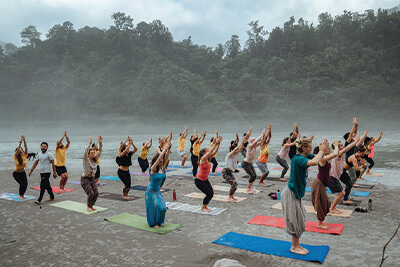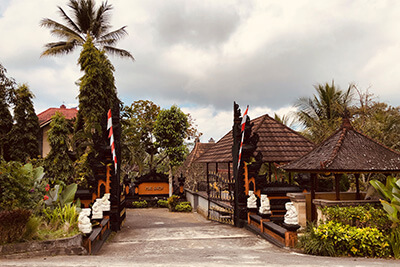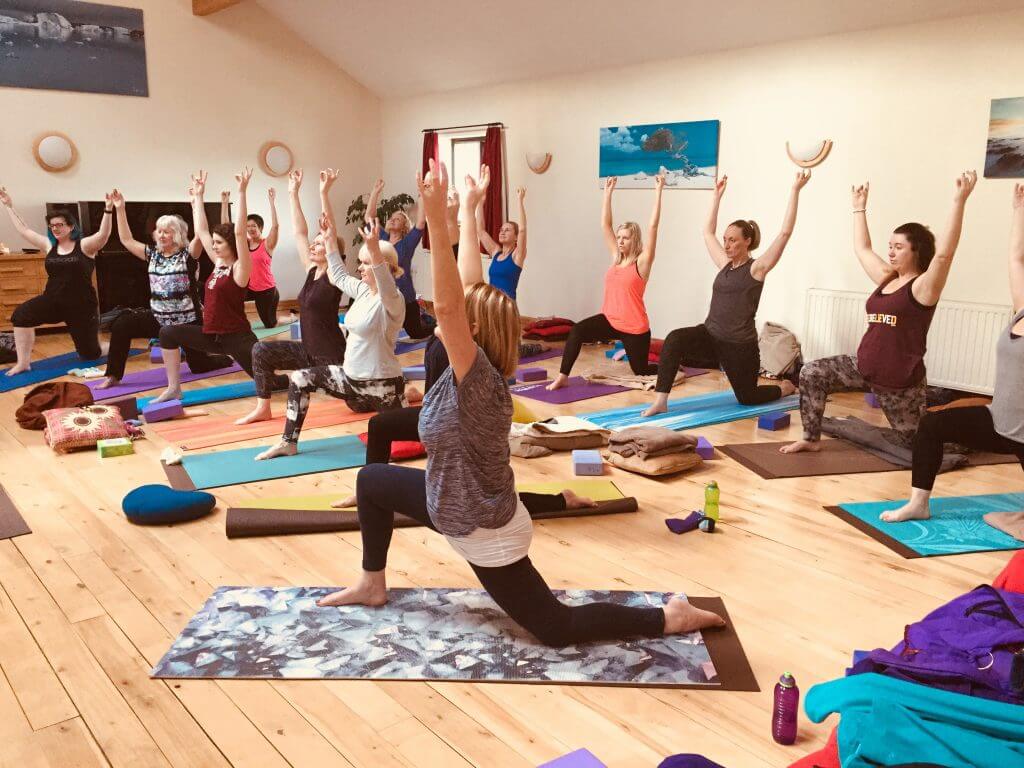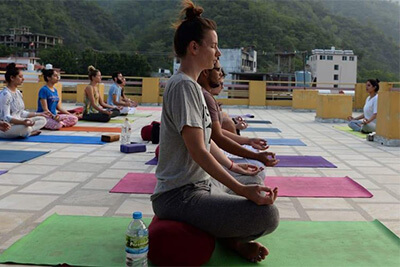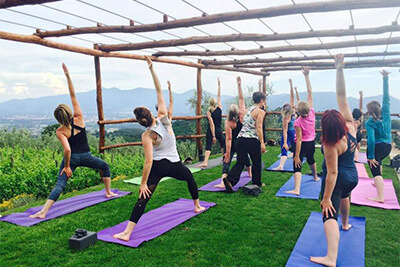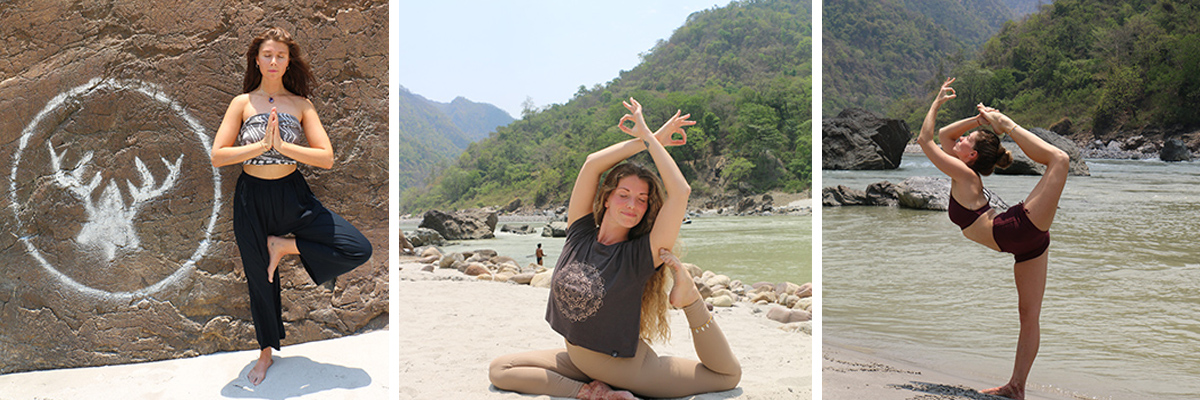
300 Hour Yoga Teacher Training in Rishikesh (Traditional Yoga TTC) - 28 Days
River Rafting
Ayurvedic Massage
Sattvic meals
Private balconies
Overview - 300 Hour Yoga Teacher Training in Rishikesh (Traditional Yoga TTC) - 28 Days
This 300 Hour Yoga Teacher Training in Rishikesh Course aims to provide higher teachings and practice of the traditional forms of yoga and its discipline in the spiritual town of Rishikesh, India. The program has been designed with the utmost care and sophistication for the 200 Hour Yoga Teacher Training graduates with the aim to take them to a higher level of their yogic journey from where they can evolve as complete Yoga Teacher and practitioners of the art form
The program has been designed according to the prestigious standards set by Yoga Alliance so, the 300 Hour Yoga Teacher Training In Rishikesh course graduates from Rishikesh Yoga Teacher Training Center can take the aspired leap in their lives as established preachers of the art on a global scale. The entire program is crafted by teachers with 300 Hours yoga teacher training and 500 Hour Yoga Teacher Training as their core area.
Have any question?
No money will be charged, feel free to enquire.
Images Gallery
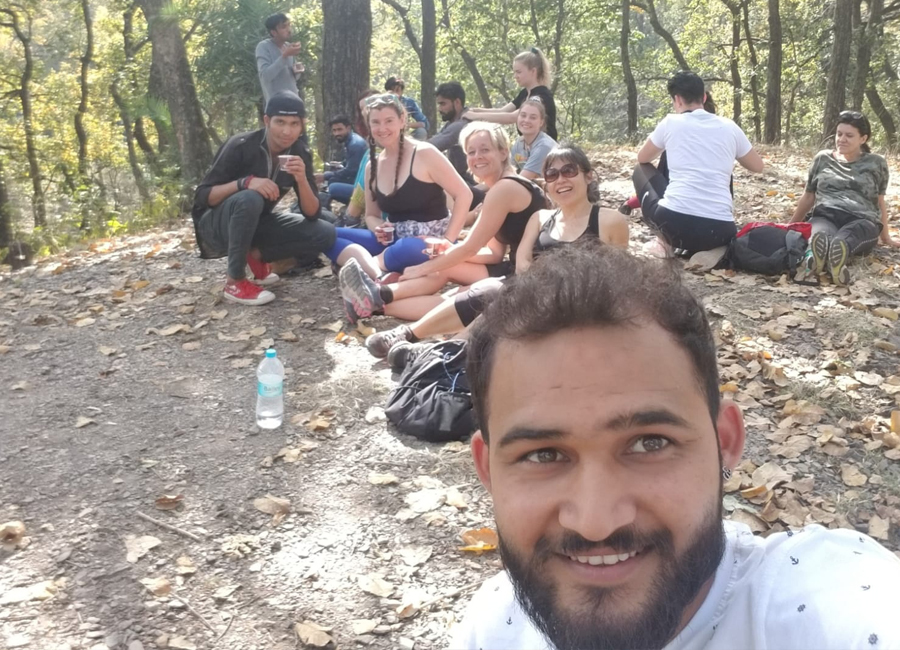

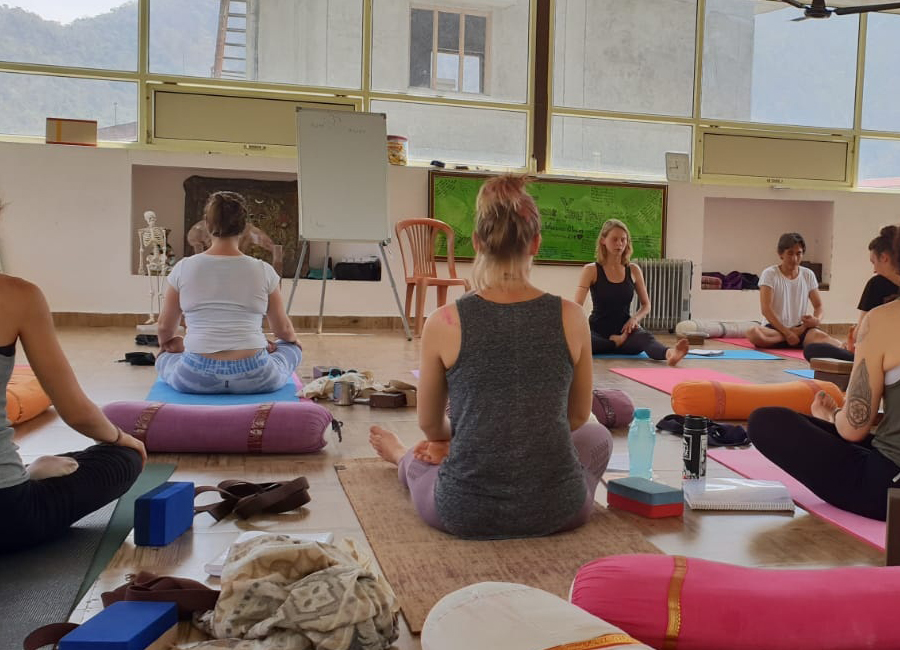
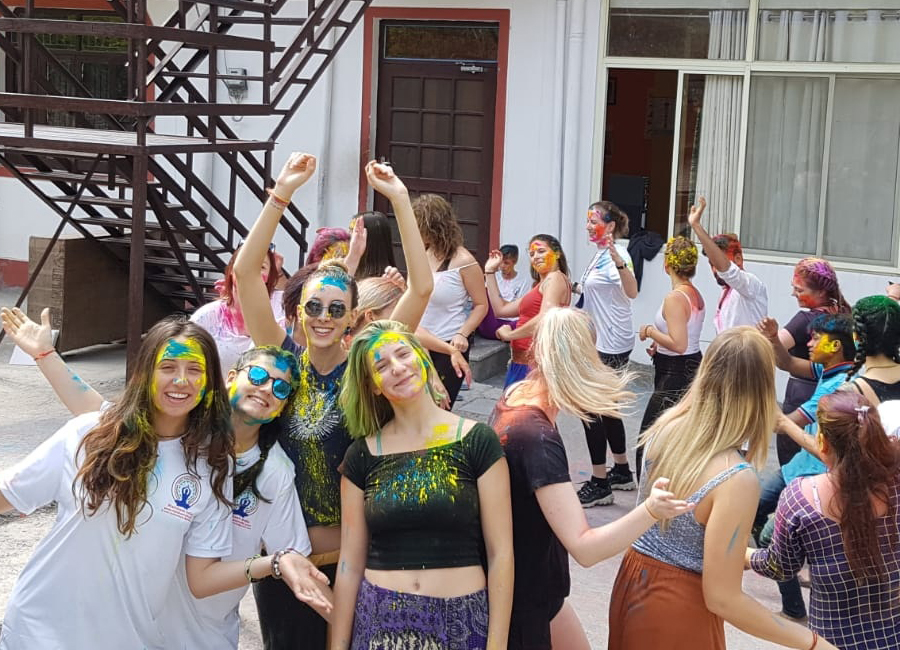
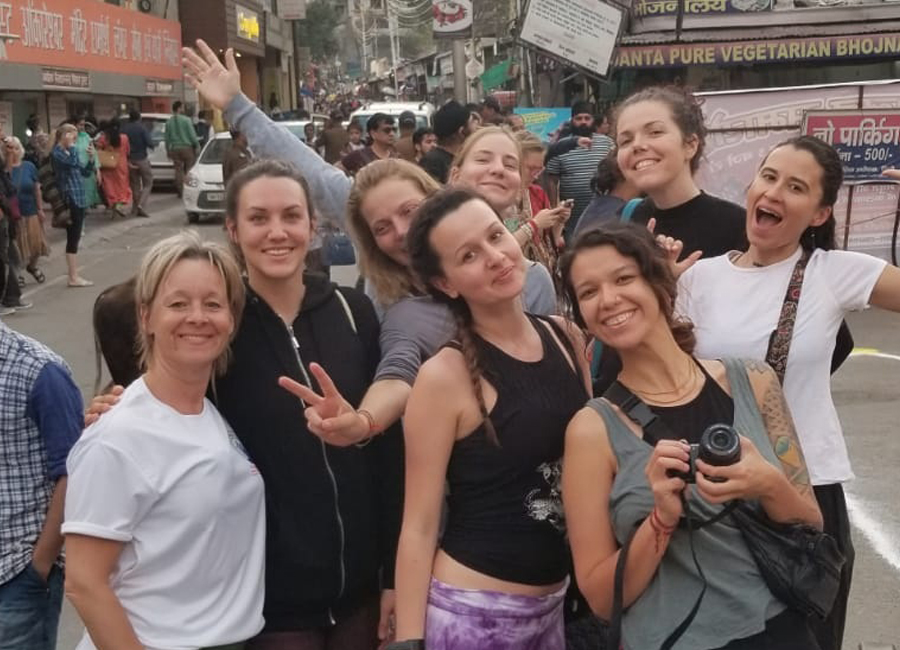
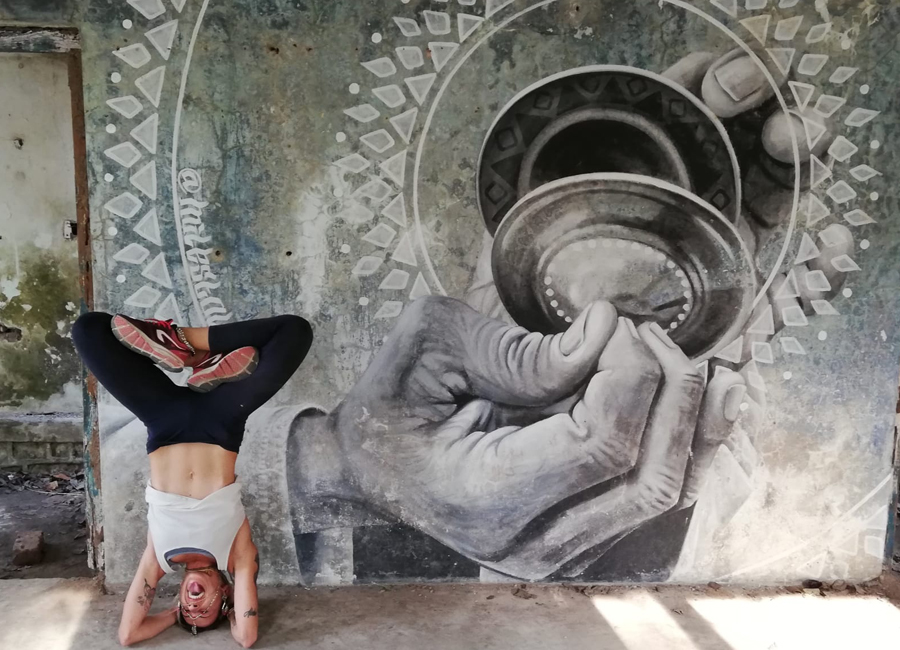
Program
This 300 hour yoga teacher training course covers In-depth teaching and training of traditional Hatha and Ashtanga Yoga styles, including optional Vinyasa Yoga classes. Furthermore, along with the teaching of the 300 hour Yoga Teacher Training In Rishikesh, you will also partake in advanced series of these two classic styles, for growth and self-progression into becoming a practitioner/teacher.
Practical and more advanced study of Anatomy and Human Movement with strong reference to yoga will be taught throughout the course. This is to give students a deeper understanding of the link between the anatomy of the human body and Asanas. Thus preparing students on how to deal with people with injuries and disease, also touching how you can prevent them by applying the right/safe technique based on different body types/levels.
Upon Completion:
- You will gain some of the most life-changing skills.
- Obtain global recognition of RYT 300 hour yoga teacher training under the ministry of Yoga Alliance as a yoga instructor of quality standards.
- Achieve thorough comprehension into advanced practices of yoga under the guidance and mentorship of highly recognized teachers, practitioners.
- Develop physically, mentally and spiritually with the tools of mindful practices while you learn how to overcome many obstacles that life throws at you.
- Learn how to safely get into the most complex positions and Asanas with confidence and lack of difficulty.
Accommodation
The ashram is located next to the famous Lakshman Jhula (also known as the hanging bridge) and the holy river Ganges. The ashram provides a beautiful location to learn and practice yoga in peace as it is situated in the foothills of the great Himalayas. Shops, cafes, restaurants, ATM and organic stores are located close to the ashram.
Both single and double rooms are available according to the student’s needs. All the rooms are neat and clean and have attached bathrooms with western toilets and hot shower. The rooms also have an attached balcony with a breathtaking view of Himalayan mountains. Bedsheets, pillows, bath towels, toilet paper, blankets, and welcome amenities are provided to the students. Wifi is available on every floor and water and laundry services are also available.
The ashram also offers budget accommodations. These rooms are separate from the main building and don't have a balcony or mountain view. All of the other facilities are also available with these rooms.
Syllabus
Yoga Postures (Asana)
Students will gain extensive knowledge of yoga postures and will increase their strength, flexibility, and discipline.
Recitation Of Sacred Sound (Mantra Chanting)
The purpose of mantra chanting in yoga is to generate vibrations and connect with the universe. Each mantra is special and rich with spiritual energy.
- Om Asato Maa Sadgamaya (mantra from Upanishad)
- Tvameva Mata Ca Pita Tvameva (Sloka on gods)
- Om Tryambakam Yajamahe (mantra on Lord Shiva)
- Om Sahana Vavatu (mantra from Upanishad)
- Guru Brahma Guru Vishnu Gurudevo maheshwara (Guru stotram)
- Yogena Cittasya (Sloka on Sage Patanjali)
- Hare Rama, Hare Krishna (Maha mantra)
- Vakratunda Mahakaya Mantra
- Om Bhur Bhuva Swaha (Gayatri mantra)
Ashtanga Vinyasa Yoga Course Syllabus
This part of the syllabus includes:
- Sun salutation A
- Sun salutation B
- Primary series & Advance posture.
- Padangusthasana - Big toe posture
- Padahastasana - Hand under foot posture
- Utthita Trikonasana - Triangle pose
- Parivrtta Trikonasana - Revolving triangle
- Utthita Parvakonasana - Extended side angle pose
- Parivritta Parsvakonasana - Revolving side angle pose
- Prasarita Padottanasana A to D - Intense wide leg stretch
- Parsvottanasana - Intense side stretch posture
- Utthita Hasta Padangusthasana - Hand to big toe posture
- Ardha Baddha Padmottanasana - Half bound lotus forward bend
- Utkatasana - Fierce pose
- Virabhadrasana A to B - Warrior
The Vinyasa (Vinyasa To Jump Back)
The Vinyasa Yoga Sllaybus includes:
- Purvottanasana - Intense east stretch
- Ardha Baddha Padma Paschimottanasana - Half bound lotus forward bend
- Tiriang Mukhaipada Paschimottanasana - Reverse the leg direction of one leg intense east stretch
- Janu Sirsasana A to C - Head to knee pose
- Marichyasana A to D
- Navasana - Boat posture
- Bhujapidasana- Shoulder pressure posture
- Kurmasana - Tortoise posture
- Supta Kurmasana - Sleeping tortoise
- Garbha Pindasana - Embryo posture
- Kukkutasana - Rooster posture
- Baddha Konasana A to B - Bound angle posture
- Upavista Konasana A to B - Seated angle posture
- Supta Konasana A to B - Lying down angle posture
- Supta Padangustasana - Reclining big toe posture
- Ubhaya Padangusthasana - Both big toes postures
- Urdhva Mukha Paschimottasana - Upward facing full forward bend
- Setu Bandhasana - Bridge
- Urdhva Dhanurasana - Upward bow posture
- Paschimottanasana - Full forward bend
- Salamba Sarvangasana - Shoulder-stand
- Halasana - Plow
- Karnapidasana - Ear pressure posture
- Urdhva padmasana - Upward lotus
- Pindasana - Embryo posture
- Matsyasana - Fish posture
- Uttana Padasana - Extended leg posture
- Sirsasana - Headstand
- Yoga Mudra - Sealed yoga posture
- Padmasana - Lotus
- Uttpluthi - uprooting
- Shavasana - Corpse posture
Mudra (Yoga Gestures)
The Vinyasa Yoga Syllabus includes:
- Purvottanasana - Intense east stretch
- Ardha Baddha Padma Paschimottanasana - Half bound lotus forward bend
- Tiriang Mukhaipada Paschimottanasana - Reverse the leg direction of one leg intense east stretch
- Janu Sirsasana A to C - Head to knee pose
- Marichyasana A to D
- Navasana - Boat posture
- Bhujapidasana- Shoulder pressure posture
- Kurmasana - Tortoise posture
- Supta Kurmasana - Sleeping tortoise
- Garbha Pindasana - Embryo posture
- Kukkutasana - Rooster posture
- Baddha Konasana A to B - Bound angle posture
- Upavista Konasana A to B - Seated angle posture
- Supta Konasana A to B - Lying down angle posture
- Supta Padangustasana - Reclining big toe posture
- Ubhaya Padangusthasana - Both big toes postures
- Urdhva Mukha Paschimottasana - Upward facing full forward bend
- Setu Bandhasana - Bridge
- Urdhva Dhanurasana - Upward bow posture
- Paschimottanasana - Full forward bend
- Salamba Sarvangasana - Shoulder-stand
- Halasana - Plow
- Karnapidasana - Ear pressure posture
- Urdhva padmasana - Upward lotus
- Pindasana - Embryo posture
- Matsyasana - Fish posture
- Uttana Padasana - Extended leg posture
- Sirsasana - Headstand
- Yoga Mudra - Sealed yoga posture
- Padmasana - Lotus
- Uttpluthi - uprooting
- Shavasana - Corpse posture
Meditation (Dhyana)
Meditation is a systematic practice that promotes physical, mental and emotional tranquillity with the purpose of reaching Samadhi (self-realization).
- Introduction to meditation
- Why Meditation?
- Meditation and brain waves
- Meditation and its effect on stress management
- Obstacles in meditation
- Role of concentration in meditation and tips for developing concentration
- Meditation on body and breath
- Om / mantra meditation
- Antat and Bahir Trataka
- Dynamic meditation
- Tips for silent mditation practice
- Japa meditation
- Ajapa japa
- Antar mouna
- Nada meditation
Yoga Cleansing (Shatkarma)
Yogic cleansing exercises are important to learn how to incorporate your breath and meditate properly during physical aspects of yoga. It also removes the blockages in the energy channels.
- Jalaneti satkarma (nasal cleansing with salty water)
- Rubber neti (nasal cleansing with a rubber string)
- Agnisar kriya
- Nauli kriya
- Kapalbhati cleansing
Detailed Study
This part of the Syllabus covers the following topics:
- Effects of pranayama in the respiratory system
- Effects of yoga practice and Nauli in the digestive system
- The muscular and skeletal system with advanced postures
- Anatomy of pelvic griddle and spine
- Nadis - The energy channel
- Prana and nervous system
- Kundalini Shakti
- Chakra
- Panchakosha
- Therapeutic applications of yoga postures and how to avoid injury in asana class
Sitting Postures
Sitting Postures course syllabus includes:
- Dandasana - Staff pose
- Paschimottanasana A to D Intense West - Stretch or sitting forward bend
Pranayama (Breathing Practices)
The Pranamaya course Syllabus includes:
- Introduction of Paranayama
- Meaning & Defination.
- Relevance of Pranayama in modern time.
- Benefits of Pranayama
- 5 Prana and Components of Pranayama
- Preparation for Pranayama
- Methods of Pranayama
- Balancing pranayama
- Vitalizing Pranayama
- Tranquilizing Pranayama
- The pranic body
- Annamaya kosha
- Manomaya kosha
- Pranamaya kosha
- Vijnanamaya kosha
- Anandamaya kosha
- Natural breathing
- Abdominal breathing
- Thoracic breathing
- Clavicular breathing
- Yogic breathing
- Nadi shodhana pranayama and its techniques
- Sheetali pranayama and its techniques
- Sheetkari pranayama
- Bhramari pranayama
- Ujjayi pranayama
- Bhastika pranayama
- Kapalbhati pranayama
- Moorchha pranayama
- Surya Bheda pranayama
- Chandra Bhedana pranayama
- Swana pranayama
Hatha Yoga Course Syllabus
Hatha Yoga course sllaybus covers the following topics:
- Alignment, assist, and adjustment
- Surya namaskar (sun salutation)
- handra namaskar (moon salutation)
- Bharadvajasana
- Lolasana - Swinging pose
- Kukkutasana - Rooster pose
- Sarpasana - Snake pose
- Shalabhasana - Locust pose
- Dhanurasana - Bow pose
- Paschimottanasana - Seated forward bend
- Janu sirshasana - Head to knee pose
- Parivirta janu sirshasana - Revolving head to knee pose
- Sarvangasana - Shoulder stand
- Padam sarvangasana - Shoulder stand lotus pose
- Sirshasana- Headstand
- Natarajasana - Lord Shiva’s pose
- Utthita Hasta Padangusthasana
- aukasana - Boat pose
- Vatayanasana - Horse face pose
- Mayurasana - Peacock pose
- Koormasana - Tortoise pose
- Chakrasana - Wheel pose
- Hanumanasana - Monkey pose
- Agnistambhasana- Fire log pose
- Brahmacharyasana - Celibate’s pose
- Astavakrasana - Eight-twists pose
- Ek pada sirasana - One foot to head pose
- Chaturanga Dandasana
- Pincha Mayurasana - Feathered peacock pose
- Eka Pada Koundinyasana - Sage koundinyasana
- Handstand - Adho Mukha Vrksasana
- Ardha Pincha Mayurasana - Dolphin pose
- Makara Adho Mukha Svanasana - Dolphin plank pose
- Bakasana - Crow pose
- Ek Pada Bakasana - One leg crow
- Utthan Pristhasana - Lizard pose
- Pashasana - Noose pose
- Parivrtta Surya Yantrasana - Sundial or compass pose
- Titibasana - Firefly pose
- Parshva Bakasana - Side crow
Teaching Practice (Adhyapanam)
Students will take turns practising their teaching skills by performing in front of their peers and teachers.
- Demonstration
- Alignment
- Instructions
Teaching Methodology
A yoga teacher should efficiently perform the practical applications of class planning and preparation. At RishikeshYTTC, the students will learn how to create a positive and peaceful class environment for an enjoyable and transformative experience.
- Positive and conscious communication
- Time management
- Qualities of a teacher
- Principles of demonstrating, observation, assisting, and correcting
- Use of voice in class
- Mental and emotional preparation for teaching
- Class preparation.
- Step by step class structure planning
- Classroom management and discipline.
- Awareness of Injuries.
Yoga Philosophy (Yoga Darshana)
Yoga philosophy is the foundation of your yoga practice and it is the key to earn yogic strength. Through the path of Vedanta Philosophy, you will establish a solid, well-rounded yoga practice.
Patanjali Yoga Sutras
The Patanjali Yoga Sutras will cover:
- Chapter 1 - Samadhi pada
- Chapter 2 - Sadhana pada
Anatomy & Yoga Therapy
Anatomy & Yoga Therapy will cover:
- Concepts of panchakosha(5 layers) and Trisharira(3 Bodies)
- Introduction to Musculoskeletal system with insights to asanas
- Respiratory system
- mechanisms and Therapeutic implications of Pranayama
- Circulatory System
- Digestive System
- Mechanisms and Therapeutic implications of Shatkarma
- Mechanisms and Therapeutic implications of Asanas
- Endocrine System
- Nervous System
Things to Do
You can do the following while your stay at Rishikesh
- Do a nutrition and lifestyle medical screening with the resident medical adviser
- Go hiking in the mountains and local valleys
- Go horse riding with local trained horses
- Go skiing in the winter, they can assist with the transportation to the nearest skiing slope 30 minutes away
- Make your own mandala paintings, dreamcatcher, and art
- Visit the Dracula's Castle located nearby in Bran
Food
All meals are prepared hygienically by our expert chefs and the vegetables used are organically grown. Only vegetarian meals are served and are included in the fees.
During the stay, all the students are expected to be on a sattvic diet which helps to keep the body fit and calm the mind. The menu has been prepared by Master Chef Sandeep Semwal who has many years of experience working at 5-Star hotels and restaurants all around the globe. Chef Sandeep has a vast knowledge about sattvic food and focuses on hygienic preparation of food so that it doesn't lose its nutritional value.
The following Meals are included:
- Breakfast
- Lunch
- Dinner
The following dietary requirement(s) are served and/or catered for:
- Vegetarian
- Organic
- Other dietary requirements on request
- If you have special dietary requirements it's a good idea to communicate it to the organizer when making a reservation.
What is Included
The 200 hour yoga teacher training course (Fusion Course) fees include the following
- Pickup from the airport
- 28 nights shared Accommodation
- 3 x Daily Yogic meal, detox juices, and teas
- Every Weekend excursions (one of the old & traditional KunjaPuri Temple in the Himalayas, famous Vasist cave in Rishikesh, Aarti at parmarth Niketan, cooking class)
- yoga material ( Yoga mat, books, notebook, pen, Pencil & body cleansing kit, etc)
- 2 x 60-minute Ayurveda massage or Swedish massage.
- Morning Himalayas tour and Rishikesh market or local tour in the city.
What is Not Included
- Airfare
- Personal Expenses
- Drop off from school to airport
How to Reach the school
By Airplane
Please book your flight to arrive at Indra Gandhi International Airport (DED), from there you can take a flight to Jolly Grant Airport (DED). Upon your arrival, the school will provide a taxi for free pickup from the airport and drop off at the school at Lakshman Jhula.
By Bus
From Indra Gandhi International Airport (DED), you will have to take a taxi to ISBT (Inter State Bus Terminal). From there you can find many governments and private buses to Rishikesh. Once you reach the Rishikesh Bus Station the school’s taxi will pick you up from there and drop you at the school free of charge.
By Train
The nearest railway station is Haridwar railway station. From there you can find many cabs and buses to Rishikesh. If you want any help with the pickup from Haridwar you can contact the school and let them know.
Cancellation Policy
The reservation requires a payment of 20% of the total price.
- If the booking is cancelled one month (31 Days) prior to the start of the retreat/course you will get 90% refund of the booking amount.
- If the booking is cancelled 30 to 15 Days prior to the start of retreat/course, you will get 50% refund of the booking amount.
- No refund will be given if the retreat/course booking is cancelled less than 15 days prior to the start of the course. Although we can adjust the 50% of your paid amount to any other retreat/course you book with us in future.
The remaining amount shall be paid on arrival to the course/retreat location.


